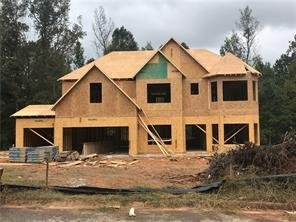A Walk Through New Home Construction
Posted by Blog Admin on Thursday, October 12th, 2017 at 10:26am.

Ever wonder what the building process looks like from the ground, up?
Buying new construction brings some excellent advantages to home owners. New homes need far less maintenance, are move-in ready, and are more energy efficient than older houses. But where does the process begin, how long does it take, and how involved is the buyer throughout it?
Presales
A “presale” is a term of art used to describe the sale of an empty lot with the intention of building a house upon it. The buyer will physically walk the lots available in a community, choose the one best suited to her needs, then choose from available floor plans that fit the lot’s dimensions. The buyer will then sit with a highly qualified sales agent to craft the Purchase and Sales Agreement, where all the major details of the transaction, including sales price, approximate closing date, and special stipulations, are noted. Generally, new homes can take anywhere from four to six months to complete, although some builders are able to complete homes within a shorter time frame.
Spec Homes
Spec homes are those homes in a community already standing and fully complete, built per the builder’s specifications as to design, color, finishes, etc. Spec homes let buyers know what the finished product looks like, are often used as “model homes,” and are a great alternative for those looking to buy new who don’t have time to wait out the construction process.
The Building Process
After you’ve chosen your lot and floor plan, construction will get underway. The lot is cleared and graded, and the foundation of your home will be poured. As the walls go up and the roof is installed, builders are constantly in touch with the local building authorities to gain proper permits and pass code enforcement that assures your home meets all local ordinances for safety.
Buyers are invited to choose their preferences for finishes, including flooring, paint, countertops, cabinets, and outdoor colors/materials. Each builder has a specific range of popular colors and products to choose from – carefully selected to ensure your home stays within the agreed upon price. Upgrades may be available, depending on the price point of the home, but the cost of those upgrades will be added to the purchase price at closing.
Remember that new construction takes time, and the amount of time is often dependent on the weather. Several days of rain can severely affect the building timeline, as contractors are scheduled in a highly methodical way to meet every synchronized step in the process.
Near the end of construction, your home will look as though it is move-in ready. However, this is when all the final touches that make it livable are happening. A final plumbing and HVAC check ensure the home’s mechanical systems work properly. Appliances will be delivered, installed, and tested. The local government will issue a Certificate of Occupancy. Finally, the home is professionally cleaned, and the buyer is invited to schedule an appointment for a “Walk-Through.”
At the final walk-through just before closing, the buyer is able to inspect the home. If the painters went thin in a spot, if the delivery guy dinged the wall or the floor when he brought in the appliances, or if a light fixture is crooked, this is the time to request that these items are made right. This is also the time when the builder will give you an introduction/education on your new home. You’ll learn where the main water shut-off is, be shown the electrical panel and how to operate it, and be given a list of numbers to call if any warranty matters should arise.
After Closing
While new homes certainly have lower maintenance costs, there are occasionally things that go wrong in the first few months. To insure against these unforeseen problems, most builders offer at least a one-year warranty on new construction homes. This covers the structure of the home, including the roof and foundation, as well as the home’s mechanical systems, such as HVAC, plumbing, electrical, and built-in appliances. Additionally, some builders may offer an extended warranty to include a second year of mechanical coverage and a 10-year structural warranty. Buyers can request this coverage, but should know that it is not an industry standard and is not offered by every builder.
While buying new may not be for everyone, it certainly has its advantages. Your home will be tailored to your tastes the minute you move in, and will need far less in the way of maintenance for the first several years. Please visit the PSP New Homes page for a complete list of new construction listings available from Peggy Slappey Properties.
Peggy Slappey Properties, Inc. is a Metro Atlanta real estate brokerage celebrating 35 years of experience in real estate sales and marketing. From new home construction to resales, we can help you find the home of your dreams. To see our current listings, visit www.psponline.com and call us for expert advice at 770-271-5555. Keep up to date with the latest PSP events and offers by checking in on Facebook at https://www.facebook.com/peggyslappeyproperties and on Twitter at https://twitter.com/psponline.
